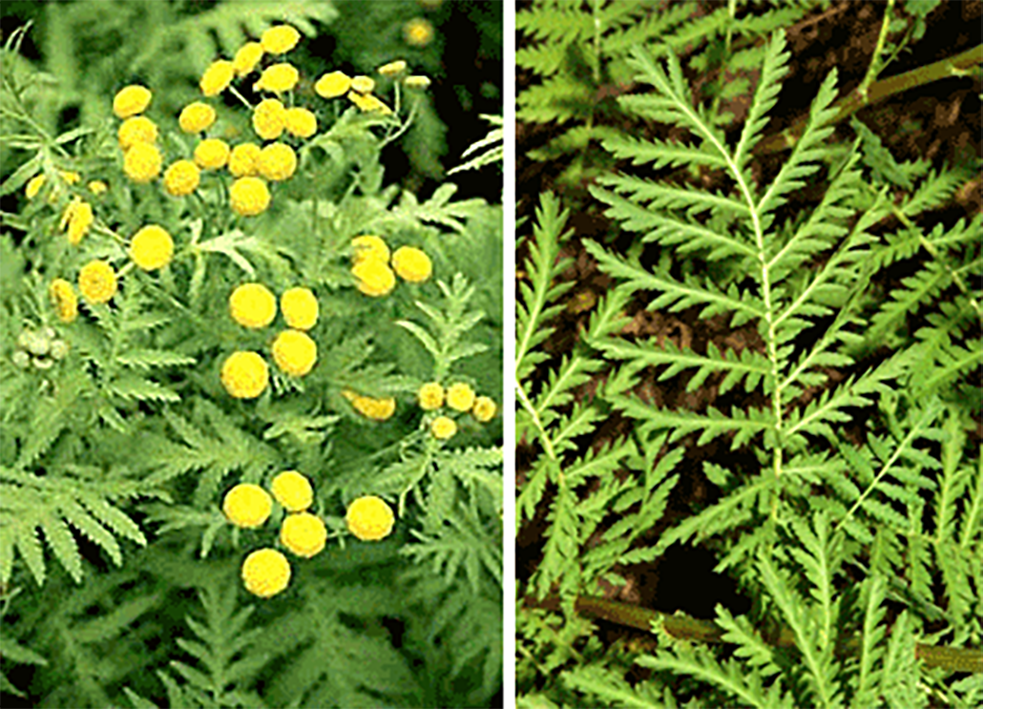 Flowering tansy
plant Tanacetum
vulgare and
tansy leaves.
Flowering tansy
plant Tanacetum
vulgare and
tansy leaves.
Welcome to the summary page for FabulousFusionFood's Herb guide to Tansy along with all the Tansy containing recipes presented on this site, with 2 recipes in total.
e This is a continuation of an entire series of pages that will, I hope, allow my visitors to better navigate this site. As well as displaying recipes by name, country and region of origin I am now planning a whole series of pages where recipes can be located by meal type and main ingredient. This page gives a listing of all the Cornish recipes added to this site.
These recipes, all contain Tansy as a major herb flavouring.
Tansy, Tanacetum vulgare (also known as Common Tansy, Bitter Buttons, Cow Bitter or Golden Buttons) is a perennial, herbaceous plant of the Asteraceae (aster) family that is native to temperate Europe and Asia, but which has been introduced to many other parts of the world. Tansy is a distinctive plant, being tall and bearing finely-divided compound leaves and yellow, button-like flowers. It has a stout, somewhat reddish, erect stem, usually smooth, 50–150 cm tall, and branching near the top. The leaves are alternate, 10–15 cm long and are pinnately lobed, divided almost to the centre into about seven pairs of segments, or lobes, which are again divided into smaller lobes having saw-toothed edges, giving the leaf a somewhat fernlike appearance. The roundish, flat-topped, button-like, yellow flower heads are produced in terminal clusters from mid-to-late summer. The scent is similar to that of camphor with hints of rosemary.
Though tansy has been used culinarily for centuries it should be noted that the leaves and flowers are toxic if consumed in large quantities; the volatile oil contains toxic compounds including thujone, which can cause convulsions and liver and brain damage. It is typically considered safe if consumed only in small quantities, as a flavouring agent, but some people are more susceptible to the toxins than others. As one of the symptoms of tansy toxicity is disorientation, as a result, as a culinary herb, tansy should be approached with caution.
Historically, tansy was used as a flavouring for puddings and omelettes, as well as for flavouring sweetmeats. During the Restoration, tansies were sweet omelettes flavoured with tansy juice. In Yorkshire, tansy and caraway seeds were traditionally used in biscuits served at funerals. The flavour is fruity and sharp with a cool heat finish, similar to peppermint. A small number of historic and modern tansy recipes are presented here, but please approach this herb with caution.
The name 'tansy' comes into English via Middle French and is ultimately derived from the Greek athanatos [ατηανατοσ], literally 'undying' or 'immortal', denoting the toughness of the plant.
e This is a continuation of an entire series of pages that will, I hope, allow my visitors to better navigate this site. As well as displaying recipes by name, country and region of origin I am now planning a whole series of pages where recipes can be located by meal type and main ingredient. This page gives a listing of all the Cornish recipes added to this site.
These recipes, all contain Tansy as a major herb flavouring.
Tansy, Tanacetum vulgare (also known as Common Tansy, Bitter Buttons, Cow Bitter or Golden Buttons) is a perennial, herbaceous plant of the Asteraceae (aster) family that is native to temperate Europe and Asia, but which has been introduced to many other parts of the world. Tansy is a distinctive plant, being tall and bearing finely-divided compound leaves and yellow, button-like flowers. It has a stout, somewhat reddish, erect stem, usually smooth, 50–150 cm tall, and branching near the top. The leaves are alternate, 10–15 cm long and are pinnately lobed, divided almost to the centre into about seven pairs of segments, or lobes, which are again divided into smaller lobes having saw-toothed edges, giving the leaf a somewhat fernlike appearance. The roundish, flat-topped, button-like, yellow flower heads are produced in terminal clusters from mid-to-late summer. The scent is similar to that of camphor with hints of rosemary.
Though tansy has been used culinarily for centuries it should be noted that the leaves and flowers are toxic if consumed in large quantities; the volatile oil contains toxic compounds including thujone, which can cause convulsions and liver and brain damage. It is typically considered safe if consumed only in small quantities, as a flavouring agent, but some people are more susceptible to the toxins than others. As one of the symptoms of tansy toxicity is disorientation, as a result, as a culinary herb, tansy should be approached with caution.
Historically, tansy was used as a flavouring for puddings and omelettes, as well as for flavouring sweetmeats. During the Restoration, tansies were sweet omelettes flavoured with tansy juice. In Yorkshire, tansy and caraway seeds were traditionally used in biscuits served at funerals. The flavour is fruity and sharp with a cool heat finish, similar to peppermint. A small number of historic and modern tansy recipes are presented here, but please approach this herb with caution.
The name 'tansy' comes into English via Middle French and is ultimately derived from the Greek athanatos [ατηανατοσ], literally 'undying' or 'immortal', denoting the toughness of the plant.
The alphabetical list of all Tansy recipes on this site follows, (limited to 100 recipes per page). There are 2 recipes in total:
Page 1 of 1
| Easter Tansy Origin: Britain | Tansy Cordial Origin: Britain |
Page 1 of 1